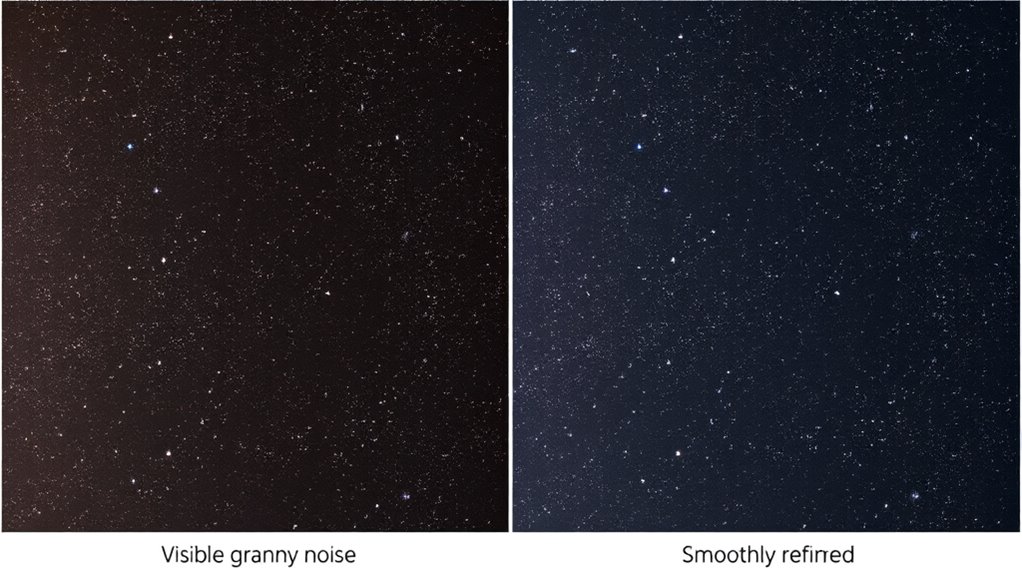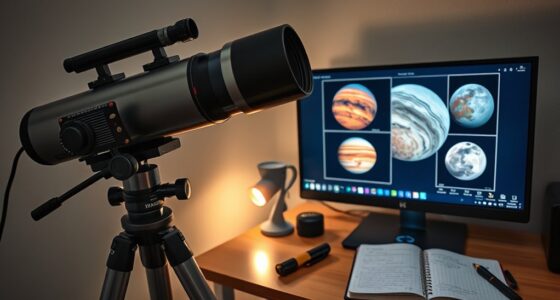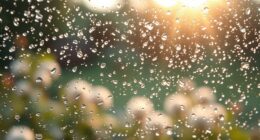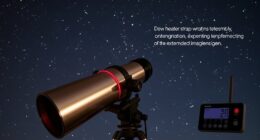To reduce noise in PixInsight, you should use algorithms like Multiscale Linear Transform and TGV denoising with masks to target noise without losing detail. In Photoshop, try using the Reduce Noise filter or Camera Raw sliders carefully, applying sharpening afterward to preserve clarity. Proper calibration and sequencing are key for best results. Keep exploring these techniques further to achieve cleaner, sharper images with minimal noise.
Key Takeaways
- Use calibration frames (darks, flats, biases) to reduce sensor artifacts before noise reduction.
- Apply PixInsight’s Multiscale Linear Transform and TGV denoising to target noise without losing detail.
- Utilize Photoshop’s Reduce Noise filter and Camera Raw sliders carefully to minimize residual noise.
- Perform sharpening selectively after noise reduction to enhance detail without amplifying noise.
- Proper sequencing—calibration, noise reduction, then sharpening—ensures cleaner, more detailed astronomical images.

Noise can be disruptive and even harmful, but effective reduction techniques can help you create a quieter, more peaceful environment. When working with digital images, particularly in astrophotography or low-light photography, noise can obscure details and diminish the overall quality of your images. To combat this, software tools like PixInsight and Photoshop offer powerful noise reduction options that, when used correctly, can substantially improve your results.
One of the critical steps in reducing noise effectively is sensor calibration. Proper sensor calibration involves capturing calibration frames such as darks, flats, and biases. These frames help correct for sensor artifacts, hot pixels, and uneven illumination, which can contribute to noise in your final image. By calibrating your sensor data, you establish a cleaner baseline, making subsequent noise reduction more effective. This process guarantees that what remains after calibration is primarily genuine image detail and minimal sensor-induced noise, allowing your noise reduction techniques to target actual noise rather than sensor imperfections.
In tools like PixInsight, noise reduction begins with algorithms specifically designed for astronomical images. Techniques such as Multiscale Linear Transform, TGV denoising, or the use of masks help isolate noise from detail, enabling you to suppress noise without sacrificing sharpness. In Photoshop, you can use filters like Reduce Noise or the Camera Raw filter’s noise reduction sliders, but applying sharpening methods judiciously is equally important. Sharpening methods enhance image details but can also amplify noise if overdone, so it’s vital to strike a balance. Using selective sharpening through masking allows you to sharpen the main subject or fine details while leaving noisy areas untouched.
In both programs, sharpening methods should be used sparingly after noise has been reduced to avoid emphasizing unwanted grain. For example, in Photoshop, you might apply a gentle Unsharp Mask or High Pass filter selectively to sharpen key features without reintroducing noise. In PixInsight, you can combine noise reduction with sharpening procedures based on the image’s frequency components, ensuring that noise is minimized while detail is maximized. Additionally, understanding the regional differences in noise can help you tailor your noise reduction approach more effectively.
Ultimately, mastering sensor calibration and sharpening methods in tandem with noise reduction tools allows you to produce cleaner, more detailed images. Proper calibration reduces the initial noise level, and careful application of sharpening methods refines the image further without reintroducing noise. Together, these techniques help you achieve a clearer, more professional-looking image, whether you’re working in PixInsight or Photoshop.
Frequently Asked Questions
How Do Noise Reduction Techniques Differ Between Pixinsight and Photoshop?
You’ll find that noise reduction techniques differ mainly in comparison algorithms and user interface. PixInsight offers advanced, customizable algorithms tailored for astrophotography, giving you precise control. Its interface is more technical but powerful. Photoshop provides more straightforward, automated options suitable for general editing, with a user-friendly interface. While PixInsight excels in detailed noise reduction, Photoshop’s simplicity makes it accessible for quick edits, though with less customization.
Can Noise Reduction Affect Image Sharpness and Detail?
Noise reduction can affect your image’s sharpness and detail if not applied carefully. While reducing noise, you might inadvertently soften fine details and reduce overall sharpness, impacting noise detail preservation. To avoid this, use techniques that balance noise reduction with sharpness preservation, adjusting settings to minimize detail loss. This way, you maintain the clarity and definition of your image while effectively managing noise.
What Are the Best Practices for Preserving Color Accuracy During Noise Reduction?
You can preserve color accuracy during noise reduction by ensuring proper color calibration first. Use calibrated monitors and color profiles to maintain tonal consistency, which helps prevent color shifts. When applying noise reduction, choose techniques that target luminance noise more than chrominance noise. Adjust settings carefully, and review your image on different screens to verify that colors remain true. Consistent calibration and subtle adjustments keep your colors vibrant and accurate.
How Do I Choose the Optimal Noise Reduction Settings for My Images?
To choose ideal noise reduction settings, start by analyzing your image’s noise characteristics and aim for a balance between noise suppression and image detail preservation. Use custom noise profiles to tailor the process to your specific data. Adjust settings gradually, preview often, and compare results to make sure you’re maintaining detail while reducing noise effectively. This hands-on approach helps you find the perfect balance for sharp, clean images.
Are There Any Free Plugins or Tools to Enhance Noise Reduction in Photoshop?
Yes, you can enhance noise reduction in Photoshop using free plugins and noise plugins. Tools like Dfine from Nik Collection or Noiseless from Topaz Labs offer free versions or trials that improve noise reduction without extra cost. These plugins integrate seamlessly into Photoshop, giving you more control over reducing noise while preserving detail. Explore these options to find the best fit for your images without spending money.
Conclusion
Just as a master painter knows when to add and when to pull back, you now understand the delicate dance of noise reduction. By choosing the right tools in PixInsight and Photoshop, you harness the power to reveal clarity amid chaos, much like turning chaos into a calm, starry night. With patience and practice, your images will shine brighter—silent poetry in every pixel, echoing the timeless art of perfecting the unseen.









